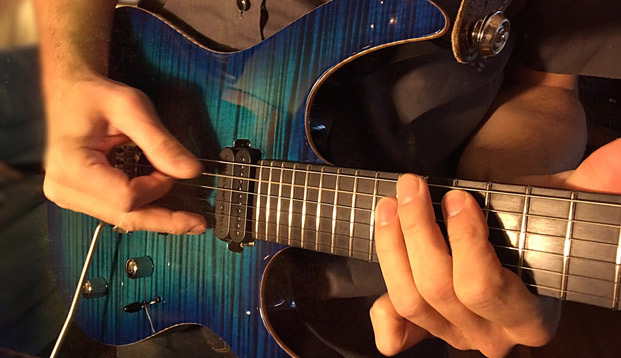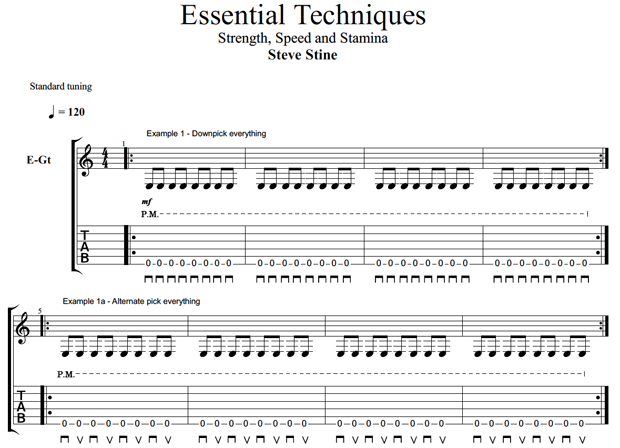Three steps to shred: daily guitar practice techniques in about 15 minutes
Some straightforward, essential practice techniques you can work into a simple, short daily routine to improve your dexterity, speed, strength and stamina.

Steve Stine, highly sought-after guitar educator, teaches live group and private classes at LessonFace.com.
No matter your level of experience, being a guitarist involves pushing your personal boundaries with the instrument.
Many players find themselves struggling to develop the physical abilities needed to play like their heroes, and, crucially, they never settle on a consistent set of exercises because they find themselves drowning in so many different suggestions.
In this column and video, I discuss some straightforward, essential practice techniques you can work into a simple, short daily routine to improve your dexterity, speed, strength and stamina to help you overcome obstacles and become a better guitar player.
These practice techniques are broken into three sections: 01. Picking hand: two three-minute exercises; 02. Fretting hand: a series of 15- or 20-second strength exercises; and 03. Both hands: a symmetrical exercise emphasizing synchronization between the left and right hands.
All in all, these exercises should take about 15 minutes. My students have found that, when done faithfully and properly, they yield significant positive results. Please note that it's a good idea to stretch out your hands, wrists and arms for a few minutes before doing these exercises.
01.Picking Hand: Three-Minute Picking Technique
This straightforward exercise is broken into two sections: First, perform a series of eighth-note downstrokes in rhythm, at a speed that is comfortable to you, for a period of three straight minutes. Follow this by performing a series of eighth-notes in rhythm using alternate picking — a downstroke followed by an upstroke — at the same speed for the full three minutes. Performing these simple exercises each for the full three minutes allows you to develop your stamina and rhythm abilities, meanwhile developing valuable muscle memory in your picking hand.

While it seems simple, this exercise can be conceptually difficult in that it often tries the patience of guitarists eager to move on to faster speeds. Just remember: Using a metronome is not a contest. It is important to be honest with yourself about what speed is comfortable for the full three minutes, and resist any urges to rush on to a higher speed you cannot maintain.
And remember there is no reason to feel bad about starting with what may seem like a slow speed. Don't let your ego interfere with your practice routine. Sure, there are higher speeds that may be comfortable for a matter of 20 seconds, but you should stick to the speed where you can “lock in," that you can comfortably maintain for the full three minutes, and use that speed with this exercise each day.
The alternate-picked section of this exercise initially should be done at the same speed as your downstrokes, which may seem slow to you at first. I advise students to start slow with the alternate picking portion to ensure their upstrokes are highly similar to their downstrokes in dynamic and attack, allowing your alternate picking to sound as identical as possible to your repeated downstrokes.
Move the metronome speed up as higher speeds become comfortable to you for the full three minutes. It may take time (weeks or months) to move up the speed, but give yourself that time. Taking an honest approach to this exercise can truly develop your picking hand technique.
02.Fretting Hand: Strength Exercises
The next step is a set of legato exercises in which you are utilizing all of the finger combinations in a few groups. These exercises require no picking at all, and are purely legato. They involve a series of hammer-ons and pull-offs performed as hard and fast as you can maintain for 15 seconds at a time. If done correctly, you will really feel this exercise in your fretting hand, wrist and forearm. Once again, it is advisable stretch your hands, wrists and arms before beginning these exercises.

Take your first (index) finger on your fretting hand and hold it at the fifth fret on the third string. Then hammer on your second (middle) finger one fret up as hard as you can (at the sixth fret on the third string) and immediately pull it off as hard as you can. Do this over and over for 15 seconds.
After 15 seconds, without stopping, perform similar hammer-ons and pull-offs with your third (ring) finger one fret up (at the seventh fret) for 15 seconds. Without stopping, follow this with a similar 15-second set of hammer-ons and pull-offs using your fourth (pinky) finger at the eighth fret. Throughout these sets of exercises, your first finger should be held at the fifth fret on the third string.
Without stopping, place and hold your second finger down at the sixth fret on the third string and hammer on and pull off your third finger one fret up at the seventh fret for 15 seconds. Then, without stopping, follow this with a similar 15 seconds of hammer-ons and pull-offs of your fourth finger at the eighth fret. Throughout these sets of exercises, your second finger should be held at the sixth fret on the third string.
From there, hold your third finger at the seventh fret, and hammer on and pull off your fourth finger at the eighth fret for 15 seconds.
Once you can comfortably maintain these exercises for a period of 15 seconds, feel free to increase the times for each exercise to 20 seconds. Additionally, feel free to focus on the sections that give you the most trouble — e.g., many guitarists need extra work holding the position with their second or third fingers and performing hammer-ons and pull-offs with their third and fourth fingers. Indeed, you may want to start with these more difficult ones and move backwards toward the easier ones.
03.Both Hands: Symmetrical Exercise
Finally, I recommend closing with a straightforward synchronization exercise that is fairly common, but is important to do it correctly and do it consistently. This dexterity exercise uses your hands together to play each fretting finger across four frets to ascend and descend the strings across the neck.

The goal is effective synchronization between the two hands and to learn to transfer smoothly in each fretted interval and when switching strings across the neck. It is a good idea to use a metronome and to always go as slow as your slowest transfer, to effectively allow you to increase speed over time.
Steve Stine is a longtime and sought-after guitar teacher who is professor of Modern Guitar Studies at North Dakota State University. Over the last 27 years, he has taught thousands of students, including established touring musicians, and released numerous video guitar lesson courses via established publishers. A resident of Fargo, North Dakota, today he is more accessible than ever before through the convenience of live online guitar lessons at LessonFace.com.
LessonFace.com offers live online music lessons via videoconference, allowing you to access top teachers in a wide variety of instruments from anywhere with a broadband connection. Steve is offering a live online group class for intermediate players this summer called “The Players Series” via the LessonFace.com platform. More information about live online lessons with Steve is available at lessonface.com/player.
Get The Pick Newsletter
All the latest guitar news, interviews, lessons, reviews, deals and more, direct to your inbox!







![Joe Bonamassa [left] wears a deep blue suit and polka-dotted shirt and plays his green refin Strat; the late Irish blues legend Rory Gallagher [right] screams and inflicts some punishment on his heavily worn number one Stratocaster.](https://cdn.mos.cms.futurecdn.net/cw28h7UBcTVfTLs7p7eiLe.jpg)


